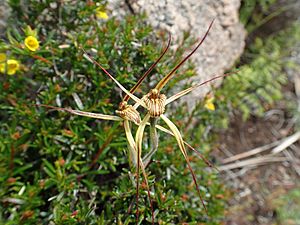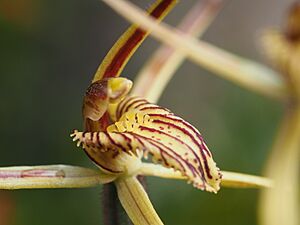Cape spider orchid facts for kids
Quick facts for kids Cape spider orchid |
|
|---|---|
 |
|
| Caladenia caesarea subsp. maritima growing near Dunsborough | |
| Conservation status | |
| Scientific classification |
|
| Kingdom: | Plantae |
| Clade: | Tracheophytes |
| Clade: | Angiosperms |
| Clade: | Monocots |
| Order: | Asparagales |
| Family: | Orchidaceae |
| Subfamily: | Orchidoideae |
| Tribe: | Diurideae |
| Genus: | Caladenia |
| Species: |
C. caesarea
|
| Subspecies: |
C. c. subsp. maritima
|
| Trinomial name | |
| Caladenia caesarea subsp. maritima Hopper & A.P.Br.
|
|
The Cape spider orchid (scientific name: Caladenia caesarea subsp. maritima) is a special type of flower. It belongs to the orchid family, which is known for its beautiful and unique plants. This orchid only grows in the south-west part of Western Australia. It's called "endemic" because it's found nowhere else in the world.
This orchid has one fuzzy leaf that spreads out. It can grow up to three small flowers. These flowers are usually a mustard-yellow color with cool red stripes. You can find them growing in groups of ten or more plants. They live in a small area along the coast near Cape Leeuwin.
Contents
What Does the Cape Spider Orchid Look Like?
The Cape spider orchid is a plant that grows from the ground. It is a perennial herb, which means it lives for more than two years. It often grows in groups of ten or more plants. This orchid has a special underground part called a tuber, which stores food.
Leaves and Flowers
Each plant has one leaf that stands up straight. This leaf is covered in tiny hairs. It can be about 6 to 9 centimeters (2.4 to 3.5 inches) long. The leaf is also about 2 to 4 millimeters (0.08 to 0.16 inches) wide.
The orchid stem grows about 15 to 20 centimeters (5.9 to 7.9 inches) tall. On this stem, you can find up to three flowers. Each flower is about 4 to 5 centimeters (1.6 to 2.0 inches) long. They are also about 5 to 6 centimeters (2.0 to 2.4 inches) wide.
Flower Details
The side parts of the flower, called sepals and petals, spread out wide. The main lip of the flower, called the labellum, is mustard-yellow. It has brownish-red stripes and sticks out clearly. The edge of the labellum is bumpy and uneven.
Along the center of the labellum, there are two rows of shiny yellow bumps. These bumps are called calli. The Cape spider orchid flowers bloom from August to mid-September. After flowering, the plant produces a dry seed pod. This pod opens up to release many tiny seeds.
How Was the Cape Spider Orchid Named?
The scientific name for this orchid is Caladenia caesarea subsp. maritima. The main species, Caladenia caesarea, was first described in 1912. This was done by a scientist named Karel Domin. He first called it Caladenia filamentosa subsp. caesarea.
Changes to the Name
Later, in 1989, two other scientists, Mark Clements and Stephen Hopper, changed its status. They decided it was a full species, not just a subspecies. Then, in 2001, Stephen Hopper and Andrew Brown described three different subspecies. One of these was subspecies maritima.
Meaning of the Name
The word maritima comes from Latin. It means "of the sea" or "coastal." This name was chosen because this particular orchid subspecies lives near the coast.
Where Does the Cape Spider Orchid Live?
The Cape spider orchid is found only in the very south-west part of Western Australia. It grows between Dunsborough and Cape Leeuwin. This area is part of the Jarrah Forest region.
Its Home Environment
You can find these orchids growing in shallow soil. They prefer to live on granite rocks. This specific orchid is only found in Meelup Regional Park. This makes it very special and unique to that area.
Protecting the Cape Spider Orchid
The Cape spider orchid is considered an "endangered" species. This means it is at high risk of disappearing forever. It is protected by two important laws:
- The Environment Protection and Biodiversity Conservation Act 1999 in Australia.
- The Wildlife Conservation Act 1950 in Western Australia.
Because it is so rare, a special plan has been made to help it recover. This plan aims to protect the orchid and help its population grow.



